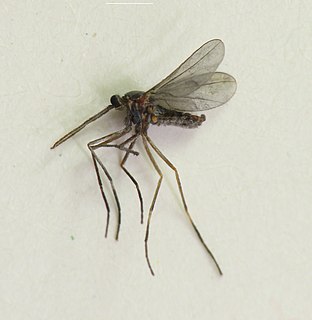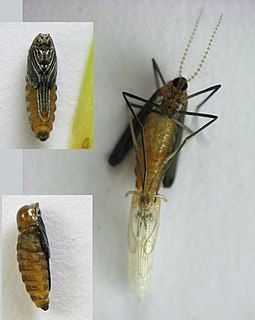
Asphondylia is a cosmopolitan genus of gall midges in the family Cecidomyiidae. All species in this genus induce galls on plants, especially on flowers and flower buds. There are over 300 described species in Asphondylia, with many more likely to be discovered and described, especially in the southern hemisphere.

Rhopalomyia is a genus of gall midges, insects in the family Cecidomyiidae. There are at least 267 described species in Rhopalomyia. Most species in this genus induce galls on plants in the Asteraceae. This genus has a cosmopolitan distribution. Rhopalomyia was first established by Ewald Heinrich Rübsaamen in 1892.
Catotricha is a genus of midges in the family Cecidomyiidae. The five described species in Catotricha are found in the holarctic region. This genus was established by British entomologist Frederick Wallace Edwards in 1938.
Amedia is a genus of wood midges in the family Cecidomyiidae. The only described species - Amedia floridana - is only known from Florida. The genus was established by Mathias Jaschhof in 1997.
Amediella is a genus of midges in the family Cecidomyiidae. The one described species - Amediella involuta - is known only from New Zealand.
Daphnephila is a genus of gall midge that appears in the Palearctic and Oriental biogeographic realms. Daphnephila species create leaf and stem galls on species of laurel plants, particularly in Machilus. Based on analysis on sequences of the mitochondrial cytochrome c oxidase subunit I, it has been suggested that in this genus, the stem-galling habit is a more ancestral state as opposed to the leaf-galling habit.
Trichoceromyia is a genus of midges in the family Cecidomyiidae. There is one described species in this genus: Trichoceromyia oregonensis. It is only known from Oregon.
Allaretella is a genus of midges in the family Cecidomyiidae. Allartella germanica is the only described species in this genus. It has been recorded in Sweden, Latvia, Germany, and Austria. The genus was first described by Hans Meyer and Voldemars Spungis in 1994.
Eomastix is a genus of midges in the family Cecidomyiidae. Eomastix incerta is the only described species in this genus and is known from Norway and Sweden. The genus was established by Mathias Jaschhof in 2009.
Gongromastix is a genus of midges in the family Cecidomyiidae. The five described species in this genus are known from the holarctic and oriental regions. It was established by Günther Enderlein in 1936.
Lestremia is a genus of midges in the family Cecidomyiidae. There are 18 described species in this genus. It was established by French entomologist Pierre-Justin-Marie Macquart in 1826.
Neolestremia is a genus of midges in the family Cecidomyiidae. The three described species in this genus are known only from India. It was established by Indian entomologist Mahadeva Subramania Mani in 1934.
Wasmanniella is a genus of midges in the family Cecidomyiidae. The three described species are known from the holarctic and oriental regions. The genus was established by French entomologist Jean-Jacques Kieffer in 1898.
Mesotrichoca is a genus of midges in the family Cecidomyiidae. The one described species in the genus - Mesotrichoca mesozoica - is known only from Siberia from a sediment fossil associated with the Late Jurassic and Lower Cretaceous epochs. This species was placed in Catotricha when it was first described by Russian entomologist Vladimir Grigoryevich Kovalev. This genus was established by Mathias Jaschhof and Catrin Jaschhof in 2008.
Anodontoceras is a genus of wood midges in the family Cecidomyiidae. There are three described species. The genus was established by Japanese entomologist Junichi Yukawa in 1967.
Ansifera is a genus of midges in the family Cecidomyiidae. The five described species are found in the Palearctic and Oriental regions. The genus was first described by Mathias Jaschhof in 2009.
Antennardia is a genus of midges in the family Cecidomyiidae. The four described species are found in the Holarctic realm. The genus was first described by Boris Mamaev in 1993, but was subsequently treated as a subgenus of Monardia until being reinstated at the genus level.
Berestella is a genus of wood midges in the family Cecidomyiidae. The only described species - Berestella insuperabilis - is only known Rovno amber from the Late Eocene. The genus was established in 2007 and named for Ukrainian entomologist Zoya L. Berest.
Bryomyia is a genus of midges in the family Cecidomyiidae. The six described species are found in the Holarctic and Oriental regions. The genus was first described by Jean-Jacques Kieffer in 1895.
Catocha is a genus of wood midges in the family Cecidomyiidae. There are eight described species. The genus was established in 1833 by Irish entomologist Alexander Henry Haliday.


